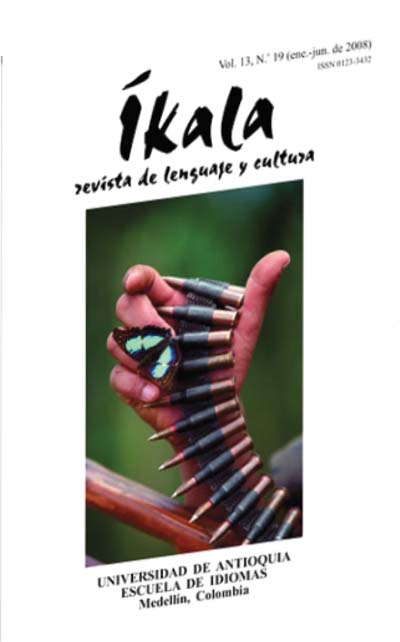Cross-linguistic influence in multilingual language acquisition: The role of L1 and non-native languages in English and Catalan oral production
DOI:
https://doi.org/10.17533/udea.ikala.2694Schlagworte:
cross-linguistic influence, third language acquisition, multilingual speaker, lexical transfer, syntactic transferAbstract
Most research in third language acquisition has focused on the effects that factors such as language distance, second language (L2) status, proficiency or recency have on the choice of the source language (L1) in cross-linguistic influence (CLI). This paper presents a study of these factors, and of the influence that the L1 (Spanish) has on L2 (English) and L3 (Catalan) oral production. Lexical and syntactic transfer are analysed in the production of Catalan and English of two multilingual speakers with similar knowledge of non-native languages. They were interviewed twice in an informal environment. The results show that the L1 is the main source of transfer, both in L2 and L3 production, but its influence decreases as proficiency in the target language increases. Language distance also plays an important role in CLI, especially if proficiency in the source language is high and if there has been recent exposure to it. The findings also suggest that while syntactic transfer is exclusively L1-based, lexical transfer can occur from a non-native language.
Received: 16-11-2007 /Accepté: 11-02-2008
How to reference this article:
Ortega, Mireia. (2008). Cross-linguistic influence in multilingual language acquisition: The role of L1 and non-native languages in English and Catalan oral production. Íkala. 13(1), pp.121-142.
Downloads
Literaturhinweise
Bild, E.R. and Swain, M. (1989). Minority language students in a French immersion programme: their French proficiency. Journal of Multilingual and Multicultural Development, 10, 255-74.
Celaya, M.L. and Torras, R. (2001). L1 influence and EFL vocabulary: Do children rely more on L1 than adult learners? Proceedings of the 25 AEDEAN Conference. Granada.
Cenoz, J., Hufeisen, B. And Jessner, U. (2001). Cross-linguistic Influence in Third Language Acquisition: Psycholinguistic Perspectives. Clevedon: Multilingual Matters.
Cenoz, J. (2001). The effect of linguistic distance, L2 status and age on cross-linguistic influence in third language acquisition. In J. Cenoz, B. Hufeisen & U. Jessner (eds.), Crosslinguistic Influence in Third Language Acquisition: Psycholinguistic Perspectives (pp. 8-20). Clevedon: Multilingual Matters.
Chomsky, N. (1959). Review of Verbal Behaviour by B.K. Skinner. Language, 35, 26-58.
Cook, V. (1995). Multi-competence and the learning of many languages. Language, Culture and curriculum, 8, 93-8.
De Angelis, G. and Selinker, L. (2001). Interlanguage transfer and competing linguistic systems in the multilingual mind. In
J. Cenoz, B. Hufeisen & U. Jessner (eds.), Cross-linguistic Influence in Third Language Acquisition: Psycholinguistic Perspectives (pp. 42-58). Clevedon: Multilingual Matters.
Dewaele, J-M. (1998). Lexical inventions: French interlanguage as L2 versus L3. Applied Linguistics, 19, 471-490.
Dewaele, J-M. (2001). Activation or inhibition? The interaction of L1, L2 and L3 on the language mode continuum. In J.
Cenoz, B. Hufeisen & U. Jessner (eds.), Cross-linguistic Influence in Third Language Acquisition: Psycholinguistic Perspectives (pp. 69-89). Clevedon: Multilingual Matters.
Ellis, R. (1985). Understanding Second Language Acquisition. Oxford: Oxford University Press.
Grosjean, F. (1992). Another view of bilingualism. In R.J. Harris (ed.), Cognitive Processing in Bilinguals (pp. 51-62). Amsterdam: North Holland.
Grosjean, F. (1998). Studying bilinguals: Methodological and conceptual issues. Bilingualism: Language and Cognition, 1, 131-49.
Hammarberg, B. (2001). Roles of L1 and L2 in L3 production and acquisition. In J. Cenoz, B. Hufeisen & U. Jessner (eds.), Cross-linguistic Influence in Third Language Acquisition: Psycholinguistic Perspectives (pp. 21-41). Clevedon: Multilingual Matters.
Jessner, U. (1999). Metalinguistic awareness in multilinguals: Cognitive aspects of third language learning. Language Awareness, 8, 3&4: 201-9.
Kellerman, E. (1983). Now you see it, now you don't. In S. Gass and L. Selinker (eds.), Language Transfer in Language Learning (pp. 112-34). Rowley, MA: Newbury House.
Kellerman, E. (1984). The empirical evidence for the influence of the L1 in interlanguage. In A. Davies et al. (eds.), Interlanguage. Edinburgh: Edinburgh University Press.
Manchón, R.M. (2001). Un acercamiento psicolingüístico al fenómeno de la transferencia en el aprendizaje y uso de segundas lenguas. In S. Pastor & V. Salazar (eds.), Estudios de lingüística (pp. 39-72). Alicante: Universidad de Alicante.
Odlin, T. (1989). Language Transfer. Cross-Linguistic Influence in Language Learning.
Cambridge: Cambridge University Press. Odlin, T. and Jarvis, S. (2004). Same source, different outcomes: A study of Swedish influence on the acquisition of English in Finland. The International Journal of Multilingualism 1, 2, 123-140.
Ringbom, H. (1986). Crosslinguistic influence and the foreign language learning process. In El. Kellerman & Shardwood Smith (eds.), Crosslinguistic Influence in Second Language Acquisition (pp. 150-62). New York: Pergamon Press.
Ringbom, H. (1987). The Role of the First Language in Foreign Language Learning. Clevedon: Multilingual Matters.
Ringbom, H. (2001). Lexical transfer in L3 production. In J. Cenoz, B. Hufeisen & U. Jessner (eds.), Cross-linguistic Influence in Third Language Acquisition: Psycholinguistic Perspectives (pp. 59-68). Clevedon: Multilingual Matters.
Ringbom, H. (2006). The importance of different types of similarity in transfer studies. In J. Arabski (eds.), Cross-linguistic Influences in the Second Language Lexicon (pp. 36-45). Clevedon: Multilingual Matters.
Navés, T., Miralpeix, I. and Celaya, M.L. (2005). Who transfers more... and what? Crosslinguistic influence in relation to school grade and language dominance in EFL. International Journal of Multilingualism, 2, 2, 1-22.
Thomas, J. (1992). Metalinguistic awareness in second – and third – language learning. In R.J. Harris (ed.), Cognitive Processing in Bilinguals (pp. 531 – 45). Amsterdam: North Holland.
Tremblay, M. (2006). Cross-linguistic influence in third language acquisition: The role of L2 proficiency and L2 exposure. CLO/OPL, 34, 109-119.
Williams, S and Hammarberg, B. (1998). Language switches in L3 production: Implications for a polyglot speaking model. Applied Linguistics 19, 295 – 333.
Downloads
Veröffentlicht
Zitationsvorschlag
Ausgabe
Rubrik
Lizenz
Copyright (c) 2008 Íkala, Revista de Lenguaje y Cultura

Dieses Werk steht unter der Lizenz Creative Commons Namensnennung - Nicht-kommerziell - Weitergabe unter gleichen Bedingungen 4.0 International.












